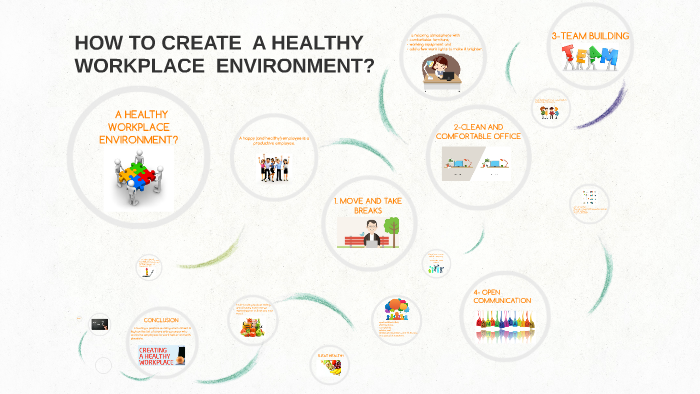“Creating a Thriving Workplace: Building a Healthy Work Environment
With excitement, let’s uncover the fascinating topic of Creating a Thriving Workplace: Building a Healthy Work Environment. Come along as we weave together engaging insights and offer a fresh perspective to our readers.
About Video Creating a Thriving Workplace: Building a Healthy Work Environment
Creating a Thriving Workplace: Building a Healthy Work Environment
In today’s fast-paced and demanding world, the concept of a healthy work environment has transcended the realm of mere buzzwords and become a critical imperative for organizations seeking sustained success. A healthy work environment is one that fosters the physical, psychological, and social well-being of its employees, leading to increased productivity, engagement, and retention. Conversely, a toxic or unhealthy workplace can lead to burnout, absenteeism, and a decline in overall performance.
This article delves into the multifaceted aspects of creating a healthy work environment, exploring the key elements, strategies, and benefits that contribute to a thriving workplace culture.
Defining a Healthy Work Environment
A healthy work environment is characterized by several key attributes:
-
Physical Safety and Well-being: A safe and ergonomically sound physical environment is paramount. This includes proper ventilation, lighting, comfortable workspaces, and adherence to safety protocols to prevent accidents and injuries.
-
Psychological Safety: This refers to a climate where employees feel comfortable taking risks, voicing opinions, and sharing ideas without fear of judgment, criticism, or retaliation.

-
Work-Life Balance: A healthy work environment recognizes the importance of employees’ personal lives and supports a balance between work and personal commitments.

Fairness and Equity: Equal opportunities, fair treatment, and transparent policies are essential for fostering trust and a sense of belonging.
-
Meaningful Work: Employees are more engaged when they find their work meaningful and aligned with their values.
-
Growth and Development: Opportunities for professional growth, learning, and skill development contribute to employee satisfaction and motivation.
-
Positive Relationships: Supportive and collaborative relationships among colleagues and between employees and management are crucial for a positive work experience.
-
Recognition and Appreciation: Acknowledging and appreciating employees’ contributions boosts morale and reinforces positive behaviors.

Key Elements of a Healthy Work Environment
Several key elements contribute to the creation of a healthy work environment:
-
Leadership Commitment:
- Leading by Example: Leaders must demonstrate a commitment to the principles of a healthy work environment through their actions and behaviors.
- Communication and Transparency: Open and honest communication from leadership builds trust and keeps employees informed.
- Support for Well-being Initiatives: Leaders should actively support and participate in well-being programs and initiatives.
-
Employee Involvement and Empowerment:
- Participatory Decision-Making: Involving employees in decision-making processes that affect their work fosters a sense of ownership and accountability.
- Autonomy and Control: Providing employees with autonomy over their work and schedules, where possible, can reduce stress and increase job satisfaction.
- Feedback Mechanisms: Establishing channels for employees to provide feedback and suggestions helps identify areas for improvement.
-
Workload Management and Stress Reduction:
- Realistic Workloads: Ensuring that employees have manageable workloads and sufficient time to complete tasks is crucial for preventing burnout.
- Stress Management Resources: Providing access to stress management programs, counseling services, and relaxation techniques can help employees cope with work-related stress.
- Encouraging Breaks and Time Off: Promoting the importance of taking regular breaks and utilizing vacation time helps employees recharge and maintain a healthy work-life balance.
-
Communication and Collaboration:
- Open Communication Channels: Establishing clear and open communication channels ensures that information flows freely between employees and management.
- Teamwork and Collaboration: Fostering a culture of teamwork and collaboration encourages employees to support each other and work together towards common goals.
- Conflict Resolution Mechanisms: Implementing effective conflict resolution mechanisms helps address disagreements and prevent them from escalating.
-
Recognition and Rewards:
- Formal Recognition Programs: Implementing formal recognition programs, such as employee of the month awards or performance bonuses, acknowledges and rewards employees’ contributions.
- Informal Appreciation: Encouraging managers and colleagues to express appreciation for each other’s work through verbal praise, thank-you notes, or small gestures of gratitude.
- Opportunities for Advancement: Providing opportunities for employees to advance their careers and develop new skills motivates them to stay engaged and committed to the organization.
-
Health and Wellness Programs:
- Health Screenings and Assessments: Offering health screenings and assessments helps employees identify potential health risks and take proactive steps to improve their well-being.
- Wellness Initiatives: Implementing wellness initiatives, such as fitness challenges, nutrition workshops, and stress management seminars, promotes healthy behaviors and lifestyles.
- Employee Assistance Programs (EAPs): Providing access to EAPs offers confidential counseling and support services to employees facing personal or work-related challenges.
Strategies for Building a Healthy Work Environment
Creating a healthy work environment is an ongoing process that requires a multifaceted approach. Here are some strategies that organizations can implement:
-
Conduct a Workplace Assessment:
- Surveys and Interviews: Conduct surveys and interviews to gather feedback from employees about their experiences and perceptions of the work environment.
- Data Analysis: Analyze data on employee absenteeism, turnover rates, and workers’ compensation claims to identify potential problem areas.
- Focus Groups: Conduct focus groups to gain a deeper understanding of specific issues or concerns.
-
Develop a Comprehensive Well-being Strategy:
- Define Goals and Objectives: Clearly define the goals and objectives of the well-being strategy, aligning them with the organization’s overall mission and values.
- Identify Key Initiatives: Identify specific initiatives that will address the identified needs and concerns of employees.
- Allocate Resources: Allocate sufficient resources, including funding, staffing, and technology, to support the implementation of the well-being strategy.
-
Implement Policies and Practices that Support Well-being:
- Flexible Work Arrangements: Offer flexible work arrangements, such as telecommuting, flextime, or compressed workweeks, to help employees balance work and personal responsibilities.
- Paid Time Off: Provide generous paid time off policies, including vacation time, sick leave, and personal days, to allow employees to rest and recharge.
- Employee Assistance Programs (EAPs): Offer access to EAPs to provide confidential counseling and support services to employees facing personal or work-related challenges.
-
Promote a Culture of Respect and Inclusion:
- Diversity and Inclusion Training: Provide diversity and inclusion training to all employees to promote awareness and understanding of different perspectives and backgrounds.
- Zero Tolerance for Harassment: Implement a zero-tolerance policy for harassment and discrimination of any kind.
- Employee Resource Groups (ERGs): Support the formation of ERGs to provide a safe and supportive space for employees from underrepresented groups.
-
Evaluate and Monitor Progress:
- Track Key Metrics: Track key metrics, such as employee satisfaction, engagement, and retention rates, to monitor the effectiveness of well-being initiatives.
- Regularly Review and Update the Strategy: Regularly review and update the well-being strategy based on feedback from employees and changes in the organization’s needs.
- Communicate Results: Communicate the results of the evaluation to employees and stakeholders to demonstrate the organization’s commitment to continuous improvement.
Benefits of a Healthy Work Environment
Investing in a healthy work environment yields numerous benefits for both employees and organizations:
- Increased Productivity: Employees who feel supported and valued are more likely to be engaged and productive.
- Reduced Absenteeism: A healthy work environment reduces stress and burnout, leading to lower absenteeism rates.
- Improved Retention: Employees are more likely to stay with organizations that prioritize their well-being.
- Enhanced Creativity and Innovation: A psychologically safe environment fosters creativity and innovation.
- Better Employee Morale: A positive work environment boosts employee morale and job satisfaction.
- Stronger Employer Brand: Organizations with a reputation for prioritizing employee well-being attract top talent.
- Reduced Healthcare Costs: Health and wellness programs can help reduce healthcare costs by promoting healthy behaviors.
Challenges and Considerations
Despite the numerous benefits, building a healthy work environment can present challenges:
- Resistance to Change: Some employees or managers may resist changes to established practices.
- Resource Constraints: Implementing well-being initiatives can require significant financial and human resources.
- Measuring Impact: It can be challenging to accurately measure the impact of well-being initiatives on organizational outcomes.
- Maintaining Consistency: Maintaining consistency in policies and practices across different departments and locations can be difficult.
Conclusion
Creating a healthy work environment is not merely a trend but a strategic imperative for organizations seeking to thrive in today’s competitive landscape. By prioritizing the physical, psychological, and social well-being of employees, organizations can foster a culture of engagement, productivity, and innovation. While challenges may arise, the benefits of a healthy work environment far outweigh the costs, making it a worthwhile investment for any organization committed to long-term success.

